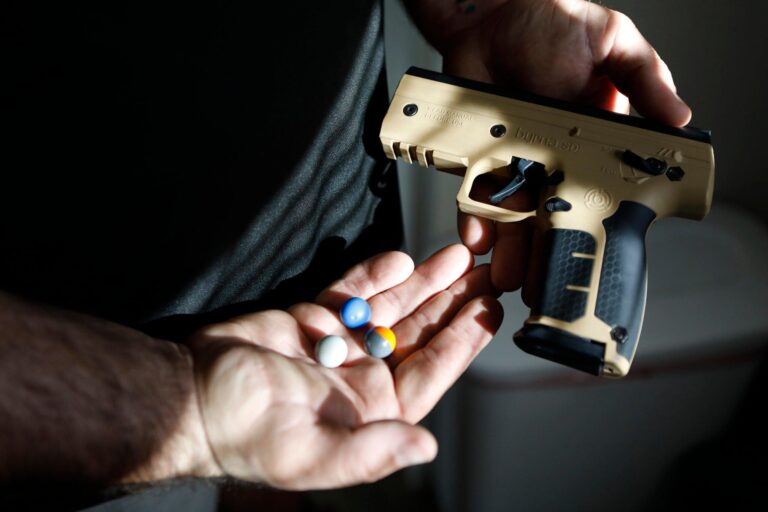Table of Contents
- Understanding the Legal Definition of Non-Lethal Self-Defense Weapons in New York State
- Exploring Permitted and Prohibited Non-Lethal Weapons Under New York Law
- Key Regulations for Carrying and Using Non-Lethal Self-Defense Tools Safely
- Practical Recommendations for Compliance and Responsible Ownership in New York State
- Key Takeaways
Understanding the Legal Definition of Non-Lethal Self-Defense Weapons in New York State
In New York State, the legal framework surrounding non-lethal self-defense weapons is designed to carefully balance personal protection rights with public safety concerns. Items such as pepper spray and stun guns fall under strict regulations that vary depending on their classification and intended use. For instance, while pepper spray is generally permitted for self-defense purposes, it must comply with specific state-approved formulations and devices, and users are prohibited from deploying it in a manner deemed reckless or unlawful. Conversely, certain non-lethal tools may require permits or licenses, highlighting the importance of understanding the nuances to avoid inadvertent legal violations.
Key legal considerations include:
- Permissible types of non-lethal weapons recognized by New York law.
- Restrictions on possession by age, location, and criminal record.
- Use of force boundaries dictating when and how these weapons may be legally employed.
- Requirements for storage and transport to remain compliant with legal mandates.
Exploring Permitted and Prohibited Non-Lethal Weapons Under New York Law
In New York, the legal landscape governing non-lethal self-defense weapons is nuanced and requires careful attention to detail. The state permits certain devices for personal protection, provided they are used in compliance with specific regulations. Commonly allowed items include pepper spray formulated for self-defense and stun guns, but only when purchased and carried by individuals over the age of 18. These tools are valued for their effectiveness in incapacitating an assailant without causing permanent harm, making them a preferable choice for those seeking to enhance personal security within the bounds of the law.
However, several non-lethal weapons are strictly prohibited under New York law due to their potential misuse or heightened risk of injury. These forbidden items include:
- Brass knuckles or any similar knuckle reinforcement
- Certain types of batons and clubs designed for combat rather than sporting use
- Devices disguised as everyday objects but intended to deliver electric shocks
Owning or carrying these prohibited weapons, even with non-lethal intent, can result in serious legal consequences including fines and criminal charges. Understanding these distinctions is crucial for responsible self-defense practices and ensuring that your actions remain within New York’s legal framework.
Key Regulations for Carrying and Using Non-Lethal Self-Defense Tools Safely
In New York State, the legal landscape around non-lethal self-defense tools is carefully designed to balance personal safety with public security. Individuals should be aware that certain items such as pepper spray are legal for self-defense, but must meet specific criteria; for instance, spray devices must be labeled as containing only OC (oleoresin capsicum) and sold by authorized vendors. Additionally, carrying devices for self-defense is permitted as long as they are not disguised as everyday objects or modified in a way that increases harm. It is also crucial to know that using these tools irresponsibly or excessively can result in serious legal consequences, including charges of assault or unlawful use of weapons.
To ensure compliance and safety, consider adhering to these key best practices:
- Purchase only approved products from licensed retailers, verifying packaging and ingredients.
- Keep the device accessible during activities where personal safety risks are higher, but avoid carrying it in restricted places like schools or government buildings.
- Undergo proper training to understand when and how to use the tool effectively without endangering yourself or others.
- Regularly check expiration dates and condition of your self-defense device to ensure functionality when needed.
Practical Recommendations for Compliance and Responsible Ownership in New York State
To navigate the complexities of New York State’s regulations on non-lethal self-defense weapons, it is essential to stay informed about the specific restrictions and allowed usage parameters. Start by thoroughly reviewing the New York Penal Law sections that govern these devices, ensuring your weapon complies with size, design, and intended use requirements. Always purchase your self-defense tools from reputable vendors who explicitly state their products meet state guidelines. Keeping meticulous records of your purchases, including receipts and any certifications, can prove invaluable in demonstrating responsible ownership if questioned by law enforcement.
Responsible ownership also means adopting best practices that prioritize safety and legality. Consider these key recommendations:
- Register your devices if required under local or state mandates.
- Store weapons securely and out of reach from unauthorized users, especially children.
- Educate yourself on proper handling and deployment techniques through certified training courses.
- Avoid public display of your self-defense tools in ways that could be misconstrued as threatening.
- Stay updated on legislative changes that might affect possession and use rights.
Key Takeaways
In conclusion, navigating New York State’s laws on non-lethal self-defense weapons requires a clear understanding of the regulations and restrictions in place. Staying informed not only helps you exercise your right to personal safety responsibly but also ensures you remain compliant with state laws. Whether considering pepper spray, stun guns, or other self-defense tools, taking the time to research and follow the legal guidelines will empower you to protect yourself confidently and legally. Remember, knowledge is your first line of defense. Stay safe and stay informed!Check Our Other Blogs
- StunGun – Your Trusted Source for Stun Guns, Laws, and Self-Defense Tips
- PepperSprayLaws – Your Trusted Resource for Pepper Spray Information
- StunGunLaws – Your Trusted Guide to Stun Gun Legality and Safety



